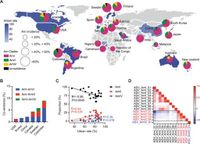The biodiversity of the gut microbiome is increasingly recognized as a crucial factor in human health, notably through the role of specific microorganisms such as Akkermansia muciniphila. Recent research has revealed that this bacterium exhibits significant genomic diversity, classified into multiple clades (AmI to AmIV), each presenting unique competitive dynamics. Key findings highlight the predominance of a single clade within individual hosts, often leading to the competitive exclusion of others, a phenomenon with potential implications for probiotic therapies.
Akkermansia muciniphila, a mucin-degrading bacterium residing in the mucus layer of the gut, has gained attention for its health benefits, including its role in maintaining intestinal barrier function and its association with reduced obesity risk. However, insights into the genetic diversity and clade-specific behaviors of this species have been limited throughout prior studies focused primarily on individual strains.
To better understand this diversity, researchers conducted genomic sequencing of 44 newly isolated strains of A. muciniphila, analyzing their phylogenetic relationships alongside available data for a total of 92 strains. The analysis confirmed the presence of distinct clades, revealing that A. muciniphila clade diversity in human populations is influenced by lifestyle factors such as urbanization. The study found that a single clade typically dominates within individual hosts, with clade co-occurrence being a rare exception.
In exploring the competitive dynamics between these clades, the study identified that extracellular vesicles (EVs) derived from clade II (AmII) inhibit the growth of clade I (AmI). This mechanism not only protects the AmII clade from competition but also highlights the role of clade-specific immunoglobulin A (IgA) responses in enhancing niche occupancy and further exclusion of AmI.
"The mechanisms driving such clade-specific exclusion remain unclear, but our findings reveal substantial competitive dynamics among A. muciniphila clades that could influence therapeutic interventions for gut health," the authors write, illustrating the study's potential impact on microbiome-related health strategies.
In vitro experiments using co-cultures of the two clades demonstrated a definitive competitive advantage for AmII despite its genetic limitations in mucin utilization—an area where AmI excels. The researchers illustrated this by showing that treatment with AmII-derived supernatants significantly inhibited AmI growth, underscoring the nuanced interactions within the gut microbiota.
Furthermore, their findings extended beyond laboratory studies. Through co-colonization experiments in germ-free mice, it was shown that pre-existing residents of the gut could suppress the colonization of incoming A. muciniphila clades, reinforcing the notion that gut dynamics are heavily influenced by prior colonization and clade composition.
"This study provides insights into the competitive dynamics of A. muciniphila clades and suggests future microbiome interventions could be optimized through personalized clade management," the authors highlight, emphasizing the therapeutic potential of A. muciniphila in next-generation probiotic formulations.
Overall, the research indicates that the clade predominance of A. muciniphila is driven by evolutionary strategies that facilitate inter-clade competition and adaptation in the gut environment. Understanding these mechanisms may provide better approaches for developing personalized probiotic therapies aimed at enhancing gut health and treating disorders related to microbiome dysbiosis.
The findings stand to enhance our grasp of how gut microbiota affects human health, opening avenues for personalized treatments tailored to individual clade compositions. As researchers continue to untangle the complex interactions within our microbiome, A. muciniphila may serve as a key player in the narrative of our gut health.




